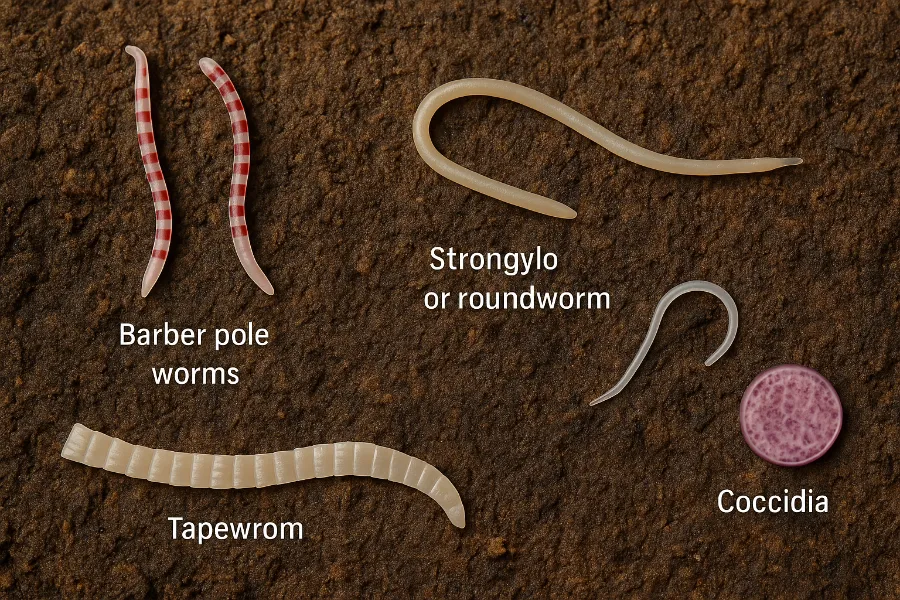When I first started raising goats, I thought worms were just part of life — something every goat owner eventually deals with. But over time, I learned that parasites don’t always start with dramatic symptoms. Instead, they creep in quietly. One day your goats look fine, and a week later, one is standing off by itself, pale-eyed and weak.
That’s why learning the early signs of worms in goats can quite literally save a life. Parasite overload doesn’t happen overnight, but the signs are easy to miss if you’re not paying attention. Today, I want to share what parasite overload really means, the 10 early signs I’ve learned to watch for, and how to stay ahead of these relentless little pests.

What Is Parasite Overload in Goats?
All goats carry some level of internal parasites — it’s completely normal. The trouble begins when that small, manageable number multiplies faster than your goat’s immune system can handle. This is what we call parasite overload.
During an overload, worms feed on blood, steal nutrients, and damage the lining of the stomach and intestines. It’s like having thousands of microscopic thieves robbing your goat’s strength from the inside out. Over time, this leads to anemia, weakness, weight loss, and in severe cases, death.
The goal isn’t to eliminate parasites entirely — that’s impossible. The real goal is to manage and monitor them, so the balance stays in your goats’ favor.
Bottle Jaw in Goats — The Swelling You Should Never Ignore
If you’ve ever noticed a soft, fluid-like swelling under a goat’s jaw, that’s something called bottle jaw. It looks puffy, like your goat has a small balloon under its chin, and it’s one of the most alarming signs of heavy parasite infestation.
Bottle jaw happens when blood-sucking worms (like the barber pole worm) cause protein loss and anemia. The fluid collects under the skin because the goat’s body can’t hold onto it properly anymore.
If you see it, act fast. Bottle jaw means the infection isn’t new — your goat’s been fighting worms for a while and needs attention right away.
Barber Pole Worm — The Silent Killer
The barber pole worm (Haemonchus contortus) is one of the deadliest parasites goats face. It lives in the stomach and feeds directly on blood. You won’t see it in the stool — but you’ll see its damage in your goats.
Goats suffering from barber pole worm infestations often develop pale eyelids, weakness, and bottle jaw. These worms reproduce fast, especially in warm, humid weather, and can cause life-threatening anemia in a matter of weeks.
Checking your goats’ eyelids regularly using the FAMACHA method is one of the best ways to spot barber pole worm infections early.
Coccidia in Goats The Hidden Threat to Kids
Not all parasites are worms. Coccidia are microscopic protozoa that wreak havoc in the intestines, especially in young kids.
While adult goats often carry coccidia without problems, kids are much more vulnerable. The classic signs are watery or pasty diarrhea, a bloated belly, poor growth, and dull coats. It can hit fast and spread quickly, especially in damp, crowded pens.
Keeping bedding dry, maintaining clean feeders, and managing stress (like weaning or weather changes) helps reduce outbreaks of coccidiosis before it becomes a full-blown issue.
Goat Dewormer — A Tool, Not a Crutch

When you notice the signs of worms in goats, the instinct is to grab a goat dewormer immediately. But here’s the truth I learned the hard way — dewormers work best when used strategically, not habitually.
Using them too often or at random can create resistance, making future treatments less effective. Always know which parasite you’re targeting and weigh your goats accurately before dosing.
I used to follow the “every goat, every month” rule — until I learned that it was doing more harm than good. Now, I deworm only when the signs point to real trouble and follow up with fecal tests whenever possible.
Building a Smarter Deworming Schedule for Goats
The best deworming schedule for goats isn’t based on a calendar — it’s based on observation. Every farm is different. Climate, pasture management, and herd size all affect how often you need to treat.
Here’s what works for me:
- Regular eyelid checks (FAMACHA): Every couple of weeks during warm months.
- Fecal egg counts: Every 6–8 weeks, especially if I notice changes in appetite or coat.
- Targeted treatments: Only treat goats that show signs or test positive for heavy loads.
- Pasture rotation: Move goats before they graze grass too short, since parasite larvae live near the soil.
This approach keeps my herd strong while reducing the risk of dewormer resistance.
Goat Parasites — The Many Faces of a Hidden Enemy
When people say “worms,” they’re usually referring to a whole army of different goat parasites. These include:
- Barber pole worms (blood-suckers causing anemia)
- Strongyles and roundworms (digestive disruptors causing weight loss and poor coat)
- Tapeworms (visible in stool, common in kids)
- Lungworms (affect breathing in rare cases)
- Coccidia (microscopic intestinal parasites)
Each one behaves differently, but the early warning signs often overlap. That’s why observation — not just medication — is your most powerful parasite management tool.
Early Signs of Parasite Overload in Goats
Now that you know what you’re up against, let’s talk about what parasite overload actually looks like before it becomes severe. These are the 10 early signs I’ve learned to recognize — and the ones you should start looking for today.
1. Pale Eyelids and Gums
Healthy goats have pink inner eyelids. When worms drain blood, that color fades to light pink or white — a sure sign of anemia. It’s subtle, but it’s often the first red flag.
2. Sudden Weight Loss
If a goat is eating like normal but still losing weight, that’s a big clue. Parasites steal nutrients before they can be absorbed, leaving your goat looking bony even with a full belly.
3. Dull or Rough Coat
A healthy goat coat should shine. When parasites take over, you’ll notice rough, dry, or patchy hair that looks lifeless. That’s the body showing nutrient deficiency from the inside out.
4. Diarrhea or Loose Stool
Soft or runny stool is a clear sign that something’s upsetting the digestive tract. It’s often the first sign of coccidia in kids and strongyle worms in adults.
5. Lethargy and Weakness
If one of your goats starts lagging behind the herd or spends more time resting, it could be because parasites have drained its energy reserves. Fatigue often appears before any other visible symptom.
6. Loss of Appetite
A goat that stops eating normally, picks at hay, or refuses grain might be dealing with stomach irritation caused by worms. This one’s easy to miss until it’s advanced — so don’t ignore subtle eating changes.
7. Pot-Bellied Appearance
This is especially common in kids. They look full in the belly but thin along the back and hips. That “pot belly” happens when worms damage the intestinal lining, making it hard for food to digest properly.
8. Poor Growth in Kids
Kids should grow quickly. If they seem undersized, weak, or just “off,” parasites could be the reason. Coccidia and intestinal worms are common growth thieves in young goats.
9. Reduced Milk Production
Lactating does under parasite stress often produce less milk. Their bodies divert nutrients to fight infection instead of fueling milk production. If multiple does drop production at once, suspect a worm bloom.
10. Swelling Under the Jaw (Bottle Jaw)
Yes, it’s worth repeating. That soft swelling under the jawline means your goat’s losing protein and blood faster than it can replace them. It’s one of the last — and most dangerous — signs before collapse.
Preventing Parasite Overload Before It Starts

Once I stopped seeing worms as a random curse and started treating parasite management as a system, everything changed. Here’s what’s helped me keep my herd healthier and more resilient year after year.
Rotate Pastures
Move goats before the grass gets grazed too low. Most parasite larvae live in the bottom few inches of vegetation.
Keep Things Clean
Lift hay feeders off the ground and clean water buckets daily. Reducing manure contact reduces reinfection.
Support Their Immunity
Strong goats fight worms better. Keep minerals available, especially copper and selenium, and feed a balanced diet with good forage.
Check Eyelids Weekly
That two-second FAMACHA check can tell you more than any fancy test. Catching pale eyelids early is how you save goats.
Use Dewormers Responsibly
Always dose correctly and recheck fecals after treatment. Treating blindly only builds resistance and wastes money.
When to Call the Vet
If you’ve tried all the above — you’ve rotated pastures, cleaned pens, dewormed correctly — and your goats still show signs of worms or anemia, it’s time to get a fecal test done by your vet. They’ll identify exactly which parasites are causing trouble and tailor the treatment for your herd.
Don’t wait until a goat collapses or stops eating completely. By that point, the worm burden may be dangerously high and much harder to treat.
Final Thoughts
Keeping goats parasite-free isn’t about killing every worm — it’s about balance, observation, and timing.
Learning the early signs of parasite overload in goats gives you the power to act before the problem explodes.
FAQs
The first signs of worms in goats often include pale eyelids, weight loss, dull coat, and loose stool. These early symptoms show your goat’s parasite load may be increasing.
Parasite overload happens when goats pick up too many worm larvae from grazing low or overused pastures. Warm, humid conditions and poor rotation make it worse.
Bottle jaw in goats is caused by severe anemia from blood-sucking worms like barber pole worm. Immediate deworming, protein support, and vet guidance are essential.
Rotate pastures, keep grass taller than 3 inches, and check eyelids regularly. Targeted deworming and fecal tests help catch barber pole worm before it becomes dangerous.
There’s no one-size-fits-all schedule. Instead of routine dosing, use a strategic deworming schedule for goats based on FAMACHA checks and fecal egg counts.
Coccidia are protozoa that cause diarrhea and stunted growth, especially in kids. Worms are internal parasites that drain blood or steal nutrients, leading to anemia and weight loss.
The best goat dewormer depends on the type of parasite and your region’s resistance patterns. Always consult your vet and follow up with a fecal test after treatment.













